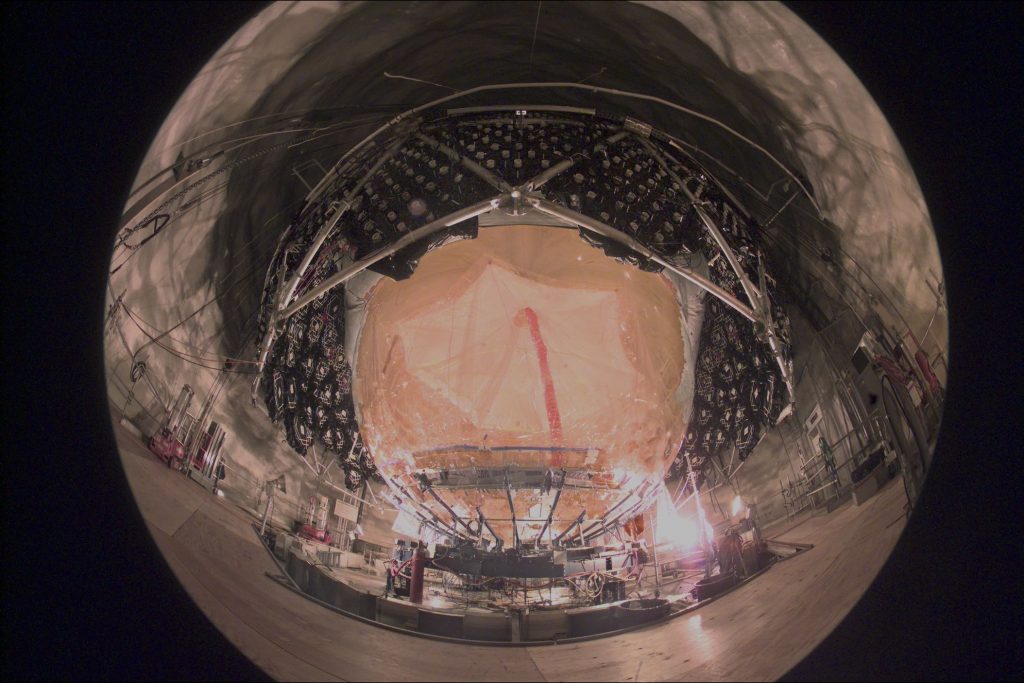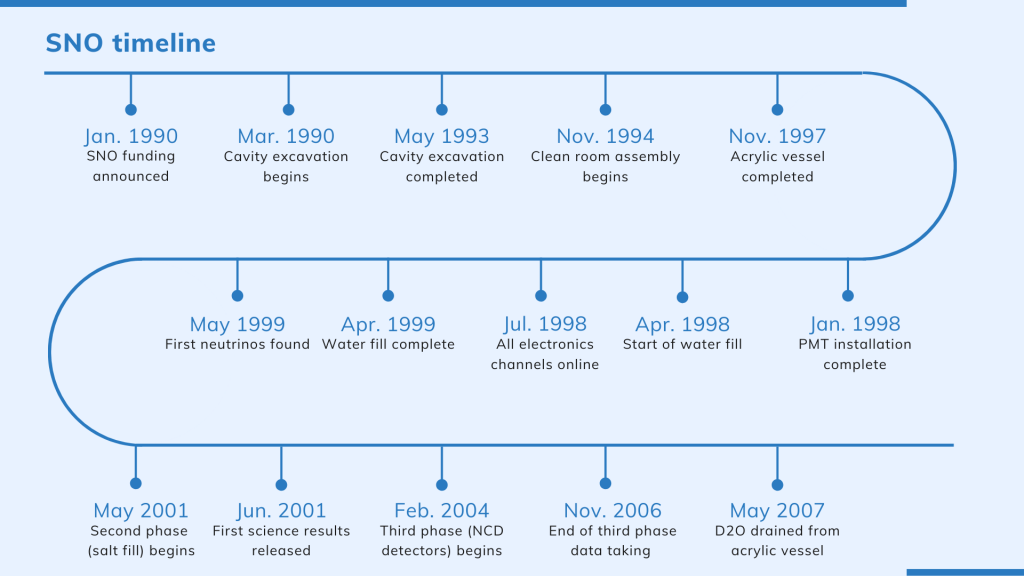30 years of SNO: Looking back at a legacy

By the early 1980s, deep underground experiments had been conducted on high energy cosmic rays, solar neutrino measurements, and searches for rare processes such as proton decay and double beta decay. To study these types of physics, the primary requirement is to reduce levels of background radiation by several orders of magnitude. Reducing background radiation is done by two means: depth and cleanliness. As a result, many of these experiments were situated in mines or within mountain tunnels.
Discussions of an underground science facility in Canada began in 1983, as it became clear that underground physics explorations had significant discovery potential. Several potential sites that would be suitable from a physics perspective were explored, with Sudbury among them. Ultimately, it was management’s openness to hosting a physics experiment that led to Inco’s Creighton Mine in Lively, ON being selected as the future location of Canada’s underground physics facility. For physics experiments of this magnitude, collaboration was needed not only within the science community but with the local community and industry partners. Since that first conversation with mining managers willing to step outside the box for SNO, the Sudbury community has continued to welcome and celebrate the physics being done here.
In the years before the SNO experiment came to fruition, Sudbury was beginning to be regarded as a hotspot for science. The once denuded landscape was being rehabilitated in Sudbury’s famous re-greening, which brought together industry, academia, government, and private citizens alike. The mining industry was making big strides towards lowering emissions. The Apollo 16 astronauts visited Sudbury in 1971 to study the landscape, as Sudbury is the site of not one, but two meteor impacts long, long ago. The trip was so successful that the following year, NASA sent the Apollo 17 crew to Sudbury to do a deeper geological assessment. It was during this trip that INCO executives were introduced to NASA scientists. Sudbury was cultivating a ground swirl of rich, interesting science.
It was this local budding culture of science that Dr. David Pearson, professor of earth sciences and science communication at Laurentian University, believes made Sudburian industry and government so receptive to hosting an experiment like SNO. “The Apollo 17 crew came because Sudbury was recognized as the site of an impact crater and it drew the widespread attention to the science that could be learned from Sudbury,” said Pearson. “I believe INCO’s willingness to host this magnificent science experiment was, in a way, conditioned by the appreciation that they had shown to the interesting geology of the basin, which had been ratcheted up by the astronauts’ visit in 1972. The idea of going to Sudbury and using a big mine was welcomed by Inco.”
From 1970 to 1994, there was a neutrino detector operating in a mine in South Dakota. The Homestake Experiment, led by Dr. Ray Davis, was set up to measure neutrinos from the Sun. Analysis of the data collected showed a problem: the detector measured only about a third the number of neutrinos predicted by theorists. The experiment appeared to be sound, so what was going on? Were there fundamental flaws in the Standard Model, and our entire understanding of physics?
Dubbed by physicists ‘The Solar Neutrino Problem’, this inconsistency became the focus of a new generation of neutrino experiments. Scientists knew that neutrinos came in three flavours: electron, muon, and tau. Up until this point, it was assumed that they did not change flavour. The Homestake experiment was sensitive only to electron neutrinos, the flavour produced in the Sun, so further investigation was needed to solve the solar neutrino problem.
In 1984, Prof. Herb Chen suggested a heavy water (D2O) detector that would be sensitive to all types of neutrinos as a candidate to investigate the solar neutrino problem. While D2O had been proposed and experimented with before, availability and cost had precluded any large-scale experiments. Canada, however, had a considerable amount of heavy water held in reserve for its CANDU nuclear reactor program. Atomic Energy of Canada Limited (AECL) was approached and agreed to loan 1,000 tonnes of heavy water to the experiment until it was needed for a new reactor, provided it was returned in the same condition it was loaned in.
What would become the SNO collaboration officially formed in 1984 with Prof. Chen and Prof. Ewan as US and Canadian spokespersons, to be joined by Prof. David Sinclair from the UK in 1985. They applied to NSERC and other international agencies to study solar neutrino physics using an underground detector. Science feasibility studies and experiment design continued over the next few years. The plan was for the detector itself to be jointly funded by Canada, the US, and UK, while the laboratory space would be funded by Canada. NSERC initially rejected the funding proposal, and it was only through discretionary funds supplied by NRC, Queen’s University, University of California, Irvine, and the University of Guelph that the SNO project continued by drilling an exploratory drift in INCO’s Creighton mine. In 1989, another one of the original collaborators, Prof. Art McDonald, moved from Princeton University to Queen’s University and became the SNO Project Director.
In 1990, SNO was funded jointly by NRC, NSERC, NOHFC, the UK and the US DOE, and work began. In addition to a 34 m tall barrel-shaped cavern for the experiment, a new drift, or lateral passageway, called the SNO drift needed to be excavated to provide access for workers, equipment, and the experiment itself. The experiment is carefully placed at a distance from the rest of the mine to reduce seismic activity from the mining operations.
The detector itself was comprised of a 12 metre diameter acrylic vessel holding heavy water, suspended in a cavity filled with ultra-pure water. The acrylic vessel was surrounded by 9,500 photomultiplier tubes arranged on a support structure, which would detect the Cherenkov light generated by neutrino interactions within the detector. Construction of the detector concluded in January 1998, and the water fill phase began in April of that year.
The SNO experiment had three data-taking phases, each looking for the same physics but with different sensitivity to the interactions of solar neutrinos. By comparing one interaction sensitive only to the electron-flavour neutrinos produced in the Sun with another interaction sensitive to all three neutrino flavours, it was possible to determine whether the electron neutrinos were changing to another flavour before reaching the detector. Years of data from the SNO experiment found that, in fact, the Sun was creating the expected number of electron neutrinos, but they were changing flavour on their journey to Earth, so the Homestake Experiment missed some of them. A change in neutrino flavour was also observed for muon neutrinos by the Super-Kamiokande detector in Japan, and the 2015 Nobel Prize in Physics was jointly awarded to Prof. Art McDonald of SNO and Dr. Takaaki Kajita of Super-K.
Professor McDonald says, “It has been an honour and a pleasure to lead the SNO Collaboration in this work. The success of the SNO experiment is a tribute to the skill and perseverance of the entire SNO team, including the scientific, engineering, construction, operations and administration members. We now know much more about one of the most elusive fundamental particles in our world and have strong confirmation that the theory of how our Sun burns is correct. The opportunity for hundreds of students and Post-Doctoral fellows to participate in science at a fundamental frontier has also created a legacy of leaders in the particle astrophysics and broader community today.”
The SNO experiment took its last data in November 2006 and was decommissioned in 2007. Data collected by SNO is still being analyzed and yielding new results to this day, and the experiment’s legacy extends beyond the contributions it made to the field of neutrino physics. According to Dr. Nigel Smith, Executive Director of SNOLAB, “The Sudbury Neutrino Observatory was a tremendous scientific accomplishment, confirming our understanding of how stars burn, and categorically demonstrating new properties of the fundamental nature of the neutrino. The SNO experiment also demonstrated that this type of project was possible in the environment of an operating nickel mine, which in itself was an amazing achievement; demonstrating the required levels of cleanliness and engineering capability to build a ten-storey experimental apparatus 2 kilometres underground.” While SNO was still running, Prof. David Sinclair led a proposal to extend the underground experiment space to host additional physics experiments requiring low-radiation environments.
Says Smith, “The success of SNO allowed the science team to propose a multi-disciplinary and multi-experiment facility to the Canadian funding agencies, which has subsequently been enthusiastically supported by federal and provincial governments, and by the host mining company, Vale. It has been a privilege over the last decade to convert that vision of a world-leading, multi-disciplinary, deep underground facility into the reality that has become SNOLAB. With the broad range of world class projects that we now support we are carrying forward the amazing legacy of the SNO project.” Today, SNOLAB has 5,000 m2 of clean underground space and hosts international experiments studying the most pressing questions in astroparticle physics.
